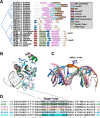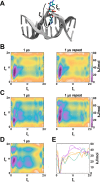The finger loop of the SRA domain in the E3 ligase UHRF1 is a regulator of ubiquitin targeting and is required for the maintenance of DNA methylation
- PMID: 31481468
- PMCID: PMC6816099
- DOI: 10.1074/jbc.RA119.010160
The finger loop of the SRA domain in the E3 ligase UHRF1 is a regulator of ubiquitin targeting and is required for the maintenance of DNA methylation
Abstract
The Su(var)3-9, enhancer of zeste, and trithorax (SET) and really interesting new gene (RING) finger-associated (SRA) protein domain is conserved across bacteria and eukaryota and coordinates extrahelical or "flipped" DNA bases. A functional SRA domain is required for ubiquitin-like with PHD and RING finger domains 1 (UHRF1) E3 ubiquitin ligase activity toward histone H3, a mechanism for recruiting the DNA methylation maintenance enzyme DNA methyltransferase 1 (DNMT1). The SRA domain supports UHRF1 oncogenic activity in colon cancer cells, highlighting that UHRF1 SRA antagonism could be a cancer therapeutic strategy. Here we used molecular dynamics simulations, DNA binding assays, in vitro ubiquitination reactions, and DNA methylation analysis to identify the SRA finger loop as a regulator of UHRF1 ubiquitin targeting and DNA methylation maintenance. A chimeric UHRF1 (finger swap) with diminished E3 ligase activity toward nucleosomal histones, despite tighter binding to unmodified or asymmetric or symmetrically methylated DNA, uncouples DNA affinity from regulation of E3 ligase activity. Our model suggests that SRA domains sample DNA bases through flipping in the presence or absence of a cytosine modification and that specific interactions of the SRA finger loop with DNA are required for downstream host protein function. Our findings provide insight into allosteric regulation of UHRF1 E3 ligase activity, suggesting that UHRF1's SRA finger loop regulates its conformation and function.
Keywords: DNA methylation; DNA-binding protein; E3 ubiquitin ligase; SRA domain; allosteric regulation; epigenetics; molecular dynamics; string method in collective variables; ubiquitin-like with PHD and RING finger domains 1 (UHRF1).
© 2019 Vaughan et al.
Conflict of interest statement
S. B. R. has served in a compensated consulting role to EpiCypher. The content is solely the responsibility of the authors and does not necessarily represent the official views of the National Institutes of Health
Figures




References
Publication types
MeSH terms
Substances
Associated data
- Actions
- Actions
- Actions
- Actions
- Actions
- Actions
Grants and funding
LinkOut - more resources
Full Text Sources
Molecular Biology Databases
Research Materials

